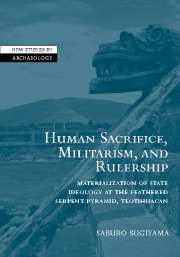 Human Sacrifice, Militarism, and Rulership
Human Sacrifice, Militarism, and Rulership Book contents
- Frontmatter
- Contents
- List of figures
- List of tables
- Acknowledgments
- 1 Introduction: cognition of state symbols and polity
- 2 Background: data and ideation
- 3 The Ciudadela and the city layout
- 4 Architecture and sculpture
- 5 Burials
- 6 Offerings
- 7 Overview: sacrificial and elite burials
- 8 Conclusion: the Feathered Serpent Pyramid as symbol of sacrifice, militarism, and rulership
- Notes
- References
- Index
8 - Conclusion: the Feathered Serpent Pyramid as symbol of sacrifice, militarism, and rulership
Published online by Cambridge University Press: 22 September 2009
- Frontmatter
- Contents
- List of figures
- List of tables
- Acknowledgments
- 1 Introduction: cognition of state symbols and polity
- 2 Background: data and ideation
- 3 The Ciudadela and the city layout
- 4 Architecture and sculpture
- 5 Burials
- 6 Offerings
- 7 Overview: sacrificial and elite burials
- 8 Conclusion: the Feathered Serpent Pyramid as symbol of sacrifice, militarism, and rulership
- Notes
- References
- Index
Summary
Symbolism
In previous chapters, I have presented analyses and interpretations of a series of programs associated with the construction of the Feathered Serpent Pyramid in the Ciudadela of Teotihuacan. This set of programs appears to have been one of many events carried out by the state for centuries at different places in the city; a dominant theme among them was probably sacrificial rites associated with large monumental constructions. To date, we still need substantial data for other cases, especially from the Sun Pyramid, to compare with those of the FSP; however, I do not believe that the events of the FSP were sector-specific, or that they were historically repeated ritual events in Teotihuacan. They most likely had a unique significance and function in the state program of consecration of the entire site. In this final chapter, my reasoning for this argument is summarized by consideration of meanings involved in these events. Finally, I discuss the events' sociopolitical implications, which centered on human sacrifice, militarism, and rulership.
Aveni (1980) and other archaeoastronomers have demonstrated that many aspects of the ancient Mesoamerican calendar system were clearly linked to astronomical observations. Astronomical objects that move with regularity and divide the sky (space) seem to have been fundamental to the Mesoamerican time-cognitive system and for symbolic conceptualization of space. Studies of Teotihuacan architectural orientation by Dow (1967), Drucker (1977b), and Aveni (1980) argue that astronomical bodies were a principal factor in the planning of the Teotihuacan city layout (see also Millon 1993: 35–36).
- Type
- Chapter
- Information
- Human Sacrifice, Militarism, and RulershipMaterialization of State Ideology at the Feathered Serpent Pyramid, Teotihuacan, pp. 220 - 244Publisher: Cambridge University PressPrint publication year: 2005


